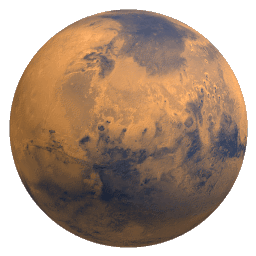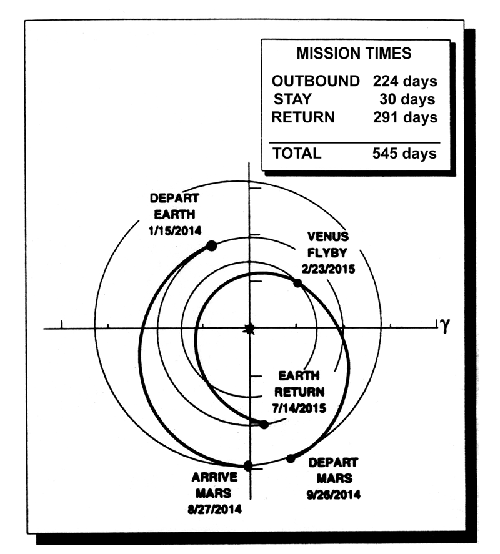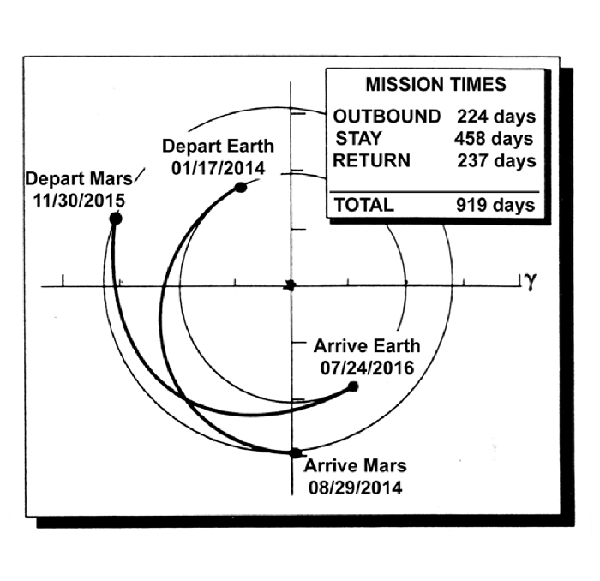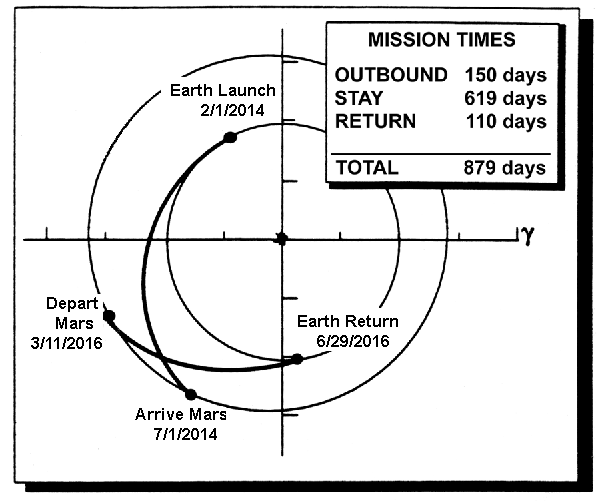 A
Crewed Mission to Mars...
A
Crewed Mission to Mars... A
Crewed Mission to Mars...
A
Crewed Mission to Mars...
![]() Mission
Objectives:
Mission
Objectives:
The "Why Mars" workshop in Houston also broadly defined 2 primary mission objectives:
1) To arrive at a better understanding of Mars both currently and historically and to answer scientific questions existing at the time of exploration (e.g. existence of subsurface water, existence of life in the past or present, global geology/tectonics, atmospheric evolution, nitrogen reservoirs etc.)
2) To demonstrate the feasibility future longer term Mars exploration and/or colonization.
![]() For
such a mission, the scientific objectives must remain flexible so that
new discoveries can influence the direction of investigation as the mission
proceeds. Secondly, the natural development of Mars surface operations
and procedures over the course of the mission will undoubtedly influence
future crewed missions in terms of equipment design and requirements.
For
such a mission, the scientific objectives must remain flexible so that
new discoveries can influence the direction of investigation as the mission
proceeds. Secondly, the natural development of Mars surface operations
and procedures over the course of the mission will undoubtedly influence
future crewed missions in terms of equipment design and requirements.

![]() Mission Profiles:
Mission Profiles:
How do we get there?
How long do we stay?
What factors influence these decisions?
1) Risk Evaluation
In planning a mission to Mars, the first consideration is crew safety. The mission can be broken down into 3 risk environments:
1) Active Space Environment - this involves the energetic portions of the mission such as launch, orbital maneuvering, and atmospheric entry, all of which will occur at Mars and Earth. The only fatal accidents, in both United States and Russian manned spacecraft, have occurred in launch or landing. High Risk
2) In-space Environment - this segment of the mission is composed of the time spent by the crew in transit to Mars and on return to Earth. While essentially uneventful, this in-transit travel time poses the next greatest risk to crew safety due to radiation exposure and zero-g. Exposure to galactic cosmic rays and solar particle events are at a maximum while in transit and the detrimental effects of zero-g on the human body are well known. While the zero-g environment could be countered by creating an artificial-g environment (by initiating a rotation of the transit vehicle), this approach could lead to difficulties in maintenance during transit and complications could arise from the spin-up/spin-down needed for maneuvering and docking procedures. For this proposed mission, it is assumed that the transit leg is carried out in zero-g. Intermediate Risk
3) Planetary Surface Environment - this refers to the time spent on the Martian surface. Astronauts will experience gravity equal to about 1/3 of that on Earth (0.38g) while on Mars and solar particle exposure will be dramatically reduced (compared with the in-space environment) due to the presence of a day/night cycle as well as the small protection provided by the Martian atmosphere. Exposure to harmful galactic cosmic rays will also be greatly reduced (75% less than in-space) due to the fact that GCRs come from every direction (in 3D) while in interplanetary space. Mars itself (as well as its atmosphere) provides protection from these rays as it will serve as a giant shield on the astronauts' feet! During their stay, the Planetary Surface Environment can be considered as a place where the astronauts will be able to at least partially recover from the effects of the zero-g transit environment. Low Risk
Conclusions:
![]() It
should be noted that the probability of an accident, either in transit
or on the Martian surface, is not considered in this risk evaluation due
to the difficulty associated with such a calculation. System and equipment
redundancy can reduce crew risk throughout the mission, but the issue of
potential accidents on the Martian surface during mission operations does
warrant future investigation. Presently, the intensive training of the
astronauts and rigorous testing of equipment are designed to reduce the
probability of an accident to an absolute minimum; the Mars mission will
meet and likely exceed these high safety standards.
It
should be noted that the probability of an accident, either in transit
or on the Martian surface, is not considered in this risk evaluation due
to the difficulty associated with such a calculation. System and equipment
redundancy can reduce crew risk throughout the mission, but the issue of
potential accidents on the Martian surface during mission operations does
warrant future investigation. Presently, the intensive training of the
astronauts and rigorous testing of equipment are designed to reduce the
probability of an accident to an absolute minimum; the Mars mission will
meet and likely exceed these high safety standards.
![]() The
Active Space Environment is an inherent risk of any mission scenario and
extensive equipment testing will be carried out to ensure crew safety during
launch, maneuvering, and entry events. The In-Space Environment is seen
as the next most harmful environment to the crew and this stage of the
mission is also the least productive. As the astronauts perform scientific
experiments and establish Mars infrastructure, the Planetary Surface Environment
will provide the greatest return on mission investment. With these safety
and productivity factors in mind, it is clear that it is important to minimize
transit time on both the inbound and outbound leg of the mission
and to maximize surface operation time.
The
Active Space Environment is an inherent risk of any mission scenario and
extensive equipment testing will be carried out to ensure crew safety during
launch, maneuvering, and entry events. The In-Space Environment is seen
as the next most harmful environment to the crew and this stage of the
mission is also the least productive. As the astronauts perform scientific
experiments and establish Mars infrastructure, the Planetary Surface Environment
will provide the greatest return on mission investment. With these safety
and productivity factors in mind, it is clear that it is important to minimize
transit time on both the inbound and outbound leg of the mission
and to maximize surface operation time.
2) Mission Profile Options: Travel times and surface stay times
Three mission profiles will be evaluated here. Each profile possesses unique characteristics such as flight trajectories, energy requirements, travel times, and surface stay times. The issue of low-earth-orbit (LEO) assembly and launch vs. ground based launch is not addressed although it is a matter which is deserving of future investigation. The three profiles considered here are:
 1)
The Short-Stay Mission - often
referred to as an opposition-class mission, this mission profile provides
Mars stay times of 30 to 90 days with a round trip total time of 400 to
650 days. This mission class requires a large amount of energy to be expended
in transit, even after taking advantage of either a Venus swingby (on either
the inbound or outbound leg) or a deep space propulsive maneuver in order
to limit Mars and Earth entry speeds.
1)
The Short-Stay Mission - often
referred to as an opposition-class mission, this mission profile provides
Mars stay times of 30 to 90 days with a round trip total time of 400 to
650 days. This mission class requires a large amount of energy to be expended
in transit, even after taking advantage of either a Venus swingby (on either
the inbound or outbound leg) or a deep space propulsive maneuver in order
to limit Mars and Earth entry speeds.
There are three distinguishing features of this mission profile. First, the time spent on the Martian surface is relatively short. This limits surface productivity by denying the astronauts of adequate time to develop significant Mars infrastructure, to demonstrate the feasibility of sustained in-situ resource utilization, or to thoroughly investigate the terrain around the landing site. In fact, over 90 percent of the total mission time is spent in the zero-g In-Space Environment, allowing little time for the astronauts to recover in the 0.38g Martian gravity. This brings us to the second point; the Venus swingby leg of the mission can last up to 360 days. Depending on the orbital positions of Earth and Mars at the time of launch, the Venus swingby may occur on the inbound or the outbound leg of the mission. Should the longer Venus swingby leg occur on the way to Mars, questions are raised about the ability of astronauts to endure physically demanding entry maneuvers and their ability to perform effectively on the surface. Then, after 90 percent of the 400 to 650 day mission is spent in the zero-g In-Space Environment with no appreciable recovery time in 0.38g, concerns for the safety of the crew arise from the cumulative exposure to the zero-g environment. Third, the Venus swingby brings the crewed spacecraft inside of the orbit of Venus (~0.7AU). Here the crew would be subjected to more intense solar particle exposure and their spacecraft would therefore require heavy shielding. In the event of a major solar particle event, the crew would need to take refuge in an even more heavily shielded portion of the spacecraft. The disadvantage here is the increased mass of the spacecraft which, on a mission with high energy requirements already, would increase energy requirements further. Due to the fact that the propellant is the largest contributor to the overall mass of any spacecraft, every attempt should be made to minimize the energy requirements, and therefore the mass, of any Mars-bound spacecraft.
 2)
Long-Stay Mission (minimum energy)
- usually referred to as a conjunction-class mission, this mission profile
provides Mars stay times up to 500 days with a round trip total time of
about 900 days. The energy requirements for this mission are the lowest
of the three considered profiles; the trade-off is the resulting long transit
time (around 250 days).
2)
Long-Stay Mission (minimum energy)
- usually referred to as a conjunction-class mission, this mission profile
provides Mars stay times up to 500 days with a round trip total time of
about 900 days. The energy requirements for this mission are the lowest
of the three considered profiles; the trade-off is the resulting long transit
time (around 250 days).
The minimum energy trajectory option has the advantage of low energy requirements. This trajectory provides an opportunity to send a more massive spacecraft (i.e. more cargo) at the same cost of a smaller spacecraft following one of the more energetic trajectories. By maximizing the payload of each launch vehicle, we can minimize the number of launches necessary to transport the required surface equipment.
The disadvantage of this trajectory for a crewed Mars launch vehicle is the crew's long exposure to the In-Space Environment. Risks to a crew following the minimum energy trajectory are similar to those described previously in the Short-Stay profile. Radiation and zero-g exposure are still quite high, although not as much shielding would be required since the spacecraft would never be inside of Earth's orbit.
![]() The minimum energy
trajectory is ideal for cargo transport from Earth to Mars. An unmanned
cargo vehicle could carry a maximum payload to Mars at a minimum energy
cost without the risks associated with a crewed vehicle.
The minimum energy
trajectory is ideal for cargo transport from Earth to Mars. An unmanned
cargo vehicle could carry a maximum payload to Mars at a minimum energy
cost without the risks associated with a crewed vehicle.
 3)
Long-Stay Mission (fast transit) - similar
to the minimum energy Long-Stay profile, this mission profile provides
long surface stay times. With sensible increases in propulsive energy,
the travel times to and from Mars can be reduced by up to 100 days each
way (one-way travel times range from 120 to 180 days), resulting in an
increase in surface stay times to a total of 600+ days. Total round trip
time for a fast transit mission is typically under 900 days.
3)
Long-Stay Mission (fast transit) - similar
to the minimum energy Long-Stay profile, this mission profile provides
long surface stay times. With sensible increases in propulsive energy,
the travel times to and from Mars can be reduced by up to 100 days each
way (one-way travel times range from 120 to 180 days), resulting in an
increase in surface stay times to a total of 600+ days. Total round trip
time for a fast transit mission is typically under 900 days.
With current propulsion technology, a point is reached where it is no longer reasonable to increase propulsive impulse in order to decrease travel time. The fast transit mission profile minimizes crew exposure to the In-Space environment and maximizes surface stay time while keeping energy requirements within reason.
While the fast transit energy reqiurements are higher than those of the minimum energy trajectory, the physical and mental benefits to the crew are unquestionably worth the investment. Additionally, the surface stay time is maximized by the fast transit profile which will allow for maximum surface productivity.
![]() It should be noted
that, due to the orbital characteristics of Earth and Mars, fast transit
times are only available for the Long-Stay mission profiles .
It should be noted
that, due to the orbital characteristics of Earth and Mars, fast transit
times are only available for the Long-Stay mission profiles .
3) Choosing a Mission Profile: The Split-Mission Strategy
From the comparison of the considered mission profiles, it is clear that the Long-Stay fast transit trajectory is both the safest and most productive option for a crewed mission to Mars.
It would be illogical (and impossible) to attempt to build one massive spacecraft to transport the Mars crew, their surface equipment, their supplies, and their return vehicle all at one time on the fast transit trajectory. The concept of a split-mission strategy becomes attractive at this time.
A split-mission strategy involves dividing the Mars mission into simpler, manageable pieces by utilizing multiple launch vehicles. By sending the surface equipment and the return vehicle to Mars on minimum energy trajectories, and by sending only the crewed vehicle on the fast transit trajectory, substantial energy savings can be made. In addition to the energy and logistic benefits of the split-mission strategy, an added degree of safety is obtained since support equipment can be sent to Mars and remotely checked out before the launch of the crewed vehicle.
4) Summary of the Chosen Mission Profile:
1) The split-mission strategy represents the most logical course of action.
2) Mars surface equipment and the Earth return vehicle (ERV) will be sent ahead of the astronauts on the minimum energy trajectory to Mars.
3) After remotely checking out the ERV and the Mars surface systems, the astronauts will be launched on the fast transit trajectory to Mars where they will rendezvous with the previously delivered surface equipment.
4) Whether to launch the required spacecraft from low-earth-orbit (LEO) or from a ground based facility is still undecided.
![]() Why Go to Mars? - motivations behind a human Mars exploration program
Why Go to Mars? - motivations behind a human Mars exploration program
![]() Launching the Mission - propulsion, launch schedule, launch payloads
Launching the Mission - propulsion, launch schedule, launch payloads
![]() Landing
on the Martian Surface - entry & landing, surface equipment, surface operations
Landing
on the Martian Surface - entry & landing, surface equipment, surface operations
![]() Surface Systems - power, return propellant production, surface life support
Surface Systems - power, return propellant production, surface life support
![]() Return to Earth - ascent from the Mars surface, Earth Return Vehicle
Return to Earth - ascent from the Mars surface, Earth Return Vehicle
![]() Back to Mars Exploration Homepage
Back to Mars Exploration Homepage
![]() NSSDCA Planetary Science Homepage
NSSDCA Planetary Science Homepage
 Author/Curator:
Author/Curator: